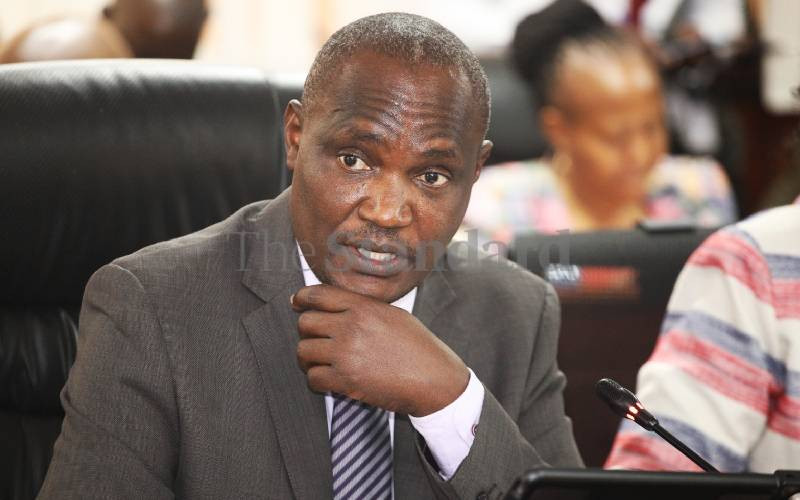By Moses Njagih
Electoral Commission has gazetted the final list of constituencies and electoral wards to be contested in coming elections, effectively removing the only hurdle on the road to the national exercise.
In publishing the final rundown of the 290 units within which parliamentary constituency and Senator and County Assembly seats will be fought, the Independent Electoral and Boundaries Commission set the ball rolling in preparation for the first elections under new Constitution.
The two processes were undeliverable earlier because voters had to first know where they would vote, and the potential candidates where they would register.
Barring ruling by court on cases that may be filed by those who feel aggrieved or fear they would not be effectively represented in the new units, the names and boundaries of 290 constituencies and 1450 county wards can now be said to be final.
There was also a shocker for Parliament from the gazettement on Tuesday: IEBC rejected the proposed additional 110 wards MPs had added to the proposed commission list.
The commission chaired by Mr Ahmed Isaack Hassan released its final report after trashing the recommendation of Parliament to increase the number of County Assembly wards to1,560.  |
IEBC chairman Mr Ahmed Isaack Hassan. The Commission gazetted the final list of constituencies and electoral wards [Photo:File/Standard] |
An analysis of the proposals along the former eight provinces shows Rift Valley retains an additional 27 constituencies, taking up its total to 76.
Nyanza gets the second highest additional electoral units with 10, which pushes up its tally to 42 constituencies.
Western and Nairobi get the second highest additional electoral units, with nine constituencies each, raising their tally to 33 and 17.
No mandate
With eight additional constituencies, Eastern will have 44, and North Eastern gets seven more, making 18.
Coast and Central Provinces are proposed to get five additional constituencies each, making 26 and 34.
"Proposals from Parliament ought to have been on general principles rather than actually creating additional wards. This is the commission’s mandate...review of the names, number and boundaries of wards," said Hassan. In effect, he declared MPs have no mandate to review the numbers of electoral areas IEBC crafted.
Stay informed. Subscribe to our newsletter
He argued it is only the commission that is mandated by the Constitution to review the names, number, and boundaries of wards, a responsibility that MPs cannot usurp. "The provision of Article 89(3) of the Constitution vests the mandate on the commission," stated Hassan, justifying the action taken and setting the stage for two crucial steps to elections – voter education and registration.
Once the list goes back to the House, MPs cannot amend it because of the constitutional powers vested on IEBC.
After publishing the electoral units, IEBC announced it would now embark on voter education on the report, before mapping out the new electoral units and kicking off voter registration in preparation for the General Election.
But IEBC announced in accordance with the law anybody seeking to challenge the report or dissatisfied with its contents has a right to file an application at the High Court, within 30 days after its publication, meaning by April 6.
The full list of will be published in The Standard tomorrow, but a glance shows there wasn’t a big departure from the initial list IEBC released, except a few changes to constituency names and ward clusters.
Hassan told The Standard IEBC had considered demands of Kenyans, including changing of names for some units, before publishing the final report.
"We decided to retain the 1,450 wards but took into account numerous demands made by Kenyans in their submissions," said Hassan
The elections chief enumerated the many challenges that the commission encountered before coming up with the report. He said the body had only stood by popular and realistic public demands.
"The commission had to wade through polarising opinions, misconception, and high (often unrealistic) expectations to come up with what may satisfy most of the people," explained Hassan. "We made great efforts to ensure that only popular and reasonable demands carried the day." He conceded it was not possible to please everyone.
Parliament’s Justice and Legal Affairs Committee had at first recommended creation of 60 more wards, bringing the number to 1,510, but the proposal was amended by the plenary, which accused committee members of acting with selfish interests in increasing the units.
Highest number
Instead, Parliament amended the committee’s report by recommending the creation of 110 more wards, most of them in the constituencies of some committee members.
With 17, Nairobi County will have the highest number of constituencies if the court ruling does not affect the list. Kiambu and Kakamega each have 12 constituencies. Nakuru County has the third highest at 11. Isiolo and Lamu have the least, with two constituencies each.
Other counties with fewer constituencies are Tana River, Tharaka Nithi, Laikipia and Samburu with three each. Embu, Kirinyaga, West Pokot, Elgeyo Marakwet and Nyamira counties also have four constituencies each.
Population quota
Hassan explained the distribution was based on population quota obtained by dividing the national population by the number of constituencies or wards as applicable.
The commission has adhered to the Task Force’s recommendation that each of the 290 constituencies has a minimum of three and a maximum of five wards. The number of wards was determined using the number of constituencies in each county, with the primary consideration for equitable representation.
At the Coast, Mombasa and Kilifi counties are recommended to have two more constituencies, and Kwale one. Lamu, Tana River and Taita Taveta Counties have no new electoral areas. All the three constituencies in Mandera County have been split to create Banissa, Mandera North, and South constituencies.
In Kitui County, proposed new constituencies include Kitui Rural, Mwingi West, and East. Kibwezi in Makueni County has been split into Kibwezi East and West, while Machakos County has a new constituency – Mavoko.
The new constituencies in Mombasa are Jomvu, Nyali, Lunga Lunga, Kilifi North, and Kilifi South.
In Meru County, Buuri and Maara are the new electoral units. Thika Town and Ruiru are proposed new constituencies in Kiambu County. Ol-Jorok is recommended in Nyandarua County. Nyeri County retains its six constituencies.
North Horr leaders had, too, demanded the split of the largest constituency in size, with an area of 35, 210sqkm.
The Justice and Legal Affairs Committee is required by law to, within 14 days, table the revised preliminary report to the National Assembly, with its recommendations.
 The Standard Group Plc is a
multi-media organization with investments in media platforms spanning newspaper
print operations, television, radio broadcasting, digital and online services. The
Standard Group is recognized as a leading multi-media house in Kenya with a key
influence in matters of national and international interest.
The Standard Group Plc is a
multi-media organization with investments in media platforms spanning newspaper
print operations, television, radio broadcasting, digital and online services. The
Standard Group is recognized as a leading multi-media house in Kenya with a key
influence in matters of national and international interest.
 The Standard Group Plc is a
multi-media organization with investments in media platforms spanning newspaper
print operations, television, radio broadcasting, digital and online services. The
Standard Group is recognized as a leading multi-media house in Kenya with a key
influence in matters of national and international interest.
The Standard Group Plc is a
multi-media organization with investments in media platforms spanning newspaper
print operations, television, radio broadcasting, digital and online services. The
Standard Group is recognized as a leading multi-media house in Kenya with a key
influence in matters of national and international interest.






